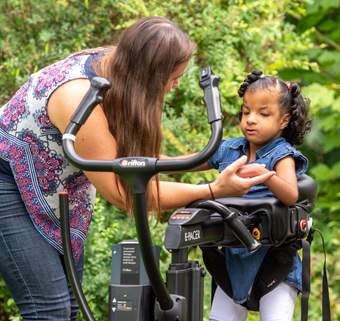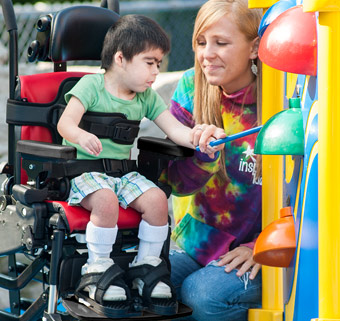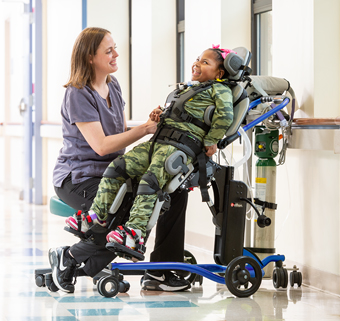Promoting Fitness, Function and Physical Activity in School-Based Physical Therapy
| March 2022 Competencies for school-based physical therapists, as outlined by the Pediatric Physical Therapy Journal, include knowledge and skills in pediatric physical therapy (PT) as well as knowledge about school structure, policy and regulations.1 Of the nine competencies stated, wellness and prevention are included.1 Correspondingly, competencies for entry-level pediatric physical therapists include health promotion and safety.2 This article presents considerations for school-based physical therapists to promote student wellness, prevention, health and safety using PT strategies to improve fitness, function and physical activity.
Competencies for school-based physical therapists, as outlined by the Pediatric Physical Therapy Journal, include knowledge and skills in pediatric physical therapy (PT) as well as knowledge about school structure, policy and regulations.1 Of the nine competencies stated, wellness and prevention are included.1 Correspondingly, competencies for entry-level pediatric physical therapists include health promotion and safety.2 This article presents considerations for school-based physical therapists to promote student wellness, prevention, health and safety using PT strategies to improve fitness, function and physical activity.
The International Classification of Functioning, Disability and Health (ICF) provides a framework for PT interventions.3 The ICF Model for children uses the “F-words” structure.4 In this model the personal dimensions are: Fitness (body structure and function); Function (activity); and Friends (participation), while the contextual factors are: Family (environmental factors); and Fun (personal factors).4 The “F-words” model provides an outline for designing PT interventions to address academic and functional needs to optimize a student’s level of participation in school, home, and community activities.1
Fitness Guidelines
Fitness interventions may include health related components such as muscle strength, muscular endurance, cardiorespiratory endurance, flexibility and body composition, and/or skill related components such as reaction time, agility, balance, power, speed, and coordination to address student goals.5 It is critical to “dose” interventions to optimize outcomes by using the American College of Sports Medicine’s FITTE principles (Frequency, Intensity, Time, Type, and Enjoyment).5 For example, evidence suggests that strength interventions for students with cerebral palsy (CP) should be done 2-4 times/week for 12-24 weeks at an intensity of 50-85% of 1 repetition maximum (RM).6 Evidence on intermediate/advanced levels of power training to improve speed and strength in youth with CP indicates that youth should participate 2-3 times/week at 3-6 sets of 1-6 reps at 60-80% of 1 RM for 20-30 minutes/session for 8-12 weeks.7,8 The FITTE principles for aerobic training specify that youth should participate in 30-60 minutes/day of moderate to vigorous physical/aerobic activity (65-93% max heart rate) such as brisk walking, swimming, running, and cycling.5,8 PT is not usually delivered at these high frequencies, so it is important for school-based physical therapists to provide students and families with recommendations on community resources such as Special Olympics, Topps Soccer, or Challenger Baseball.
Ideas to promote continued activity in school include walk/wheel events, active recess programs and increased physical activity in physical education. Also, the National Center on Health, Physical Activity and Disability (www.nchpad.org) has many resources to promote fitness, function and physical activity. Introducing active movement in short 5-10-minute bouts throughout the day is another great way to decrease sedentary behaviors and the deleterious effects of prolonged inactivity.9
Additionally, activity-based PT considers the student, the task, and environment to ensure appropriate intervention dose and design.10 For example, students with disabilities often are deconditioned with postural control challenges and musculoskeletal malalignment and often require adaptive equipment to successfully engage in the tasks or exercises.10 Best results are seen when the adaptive equipment is compatible with the school routines that promote participation. A student with decreased aerobic capacity and postural control challenges may benefit from using an Adaptive Tricycle in therapy or wheeled mobility in the school. A student who is non-ambulatory with musculoskeletal malalignment in standing may use a Mobile Stander that provides support to the level at which the student has active control to encourage participation and use of upper extremities. A student who requires an assistive device for ambulation may benefit from the Pacer Gait Trainer to support body weight and alignment during gait training to improve aerobic and muscular endurance. The following Rifton video clip provides creative ways to incorporate equipment into a student’s school day: Get Active, Get Ahead.
It is important for the school-based physical therapist to monitor progress and outcomes. Some measurement ideas include using a heart rate monitor or the OMNI-Rate of Perceived Exertion (RPE) scale for aerobic intensity.11 Strength may be measured using 6-RM; hand-held dynamometry; or repetitions in a timed test (e.g., 30 second RM sit-to-stand).12 Functional mobility may be measured using the Timed-Up-And-Go,13 and physical activity may be measured with a waist mounted activity monitor during walking14 or a wrist mounted activity monitor during upper extremity exercises.15
It is important to promote fitness, function and physical activity in order to improve health and wellness in students with disabilities in a school setting. By improving overall fitness and functional mobility, students may participate in more school and classroom activities. School-based physical therapists are creative and collaborative. They have the skills to design activity-based PT interventions, monitor outcomes, provide recommendations on resources and facilitate an “active school culture” to promote students’ overall fitness, function and physical activity.
References
- Effgen SK, Chiarello L, Milbourne SA. Updated Competencies for Physical Therapists Working in Schools. Pediatr Phys Ther. 2007;19: 266-274.
- Rapport MJ, Furze J, Martin K, Schreiber J, Dannemiller LA, DiBiasio PA, Moerchen VA. Essential competencies in entry-level pediatric physical therapy education. Pediatr Phys Ther. 2014;26:7-18.
- World Health Organization. “The International Classification of Functioning, Disability and Health - Children and Youth Version,” 2007. http://apps.who.int/classifications/icfbrowser/.
- Rosenbaum, P. and Gorter, J. W. The ‘F-words’ in childhood disability: I swear this is how we should think! Child: Care, Health and Development. 2012; 38: 457-463.
- American College of Sports Medicine, Riebe D, Ehrman JK, Liguori G, & Magal M. (2018). ACSM’s Guidelines for Exercise Testing and Prescription. (10th). Philadelphia: Wolters Kluwer Health/Lippincott Williams & Wilkins.
- Verschuren O, Ada L, Maltais D, Gorter J, Scianni A, Ketelaar M. Muscle strengthening in children & adolescents with spastic CP: Considerations for future resistance training protocols. Phys Ther. 2011; 91: 1130-9.
- Moreau NG. Muscle performance in children and youth with cerebral palsy: Implications for resistance training. In: Cerebral Palsy, 2nd edition. Miller F, Bachrach S, Lennon N, O’Neil ME (editors). Springer Books. 2019
- Verschuren O, Peterson MD, Balemans ACJ, Hurvitz EA. Exercise and physical activity recommendations for people with cerebral palsy. Dev Med Child Neurol. 2016; 58(8): 798-808.
- Verschuren, O., Darrah, J., Novak, I., Ketelaar, M., & Wiart, L. Health-Enhancing Physical Activity in Children with Cerebral Palsy: More of the Same Is Not Enough. Phys Ther. 2014; 94(2): 297-305.
- Valvano J. Activity-focused motor interventions for children with neurological conditions. Phys Occup Ther Pediatri. 2004; 24 (1-2): 79-107.
- Fragala-Pinkham M, O’Neil ME, Lennon N, Forman JL, Trost SG. Validity of the OMNI rating of perceived exertion scale for children and adolescents with cerebral palsy. Dev Med Child Neurol. 2015; 57(8):748-53.
- Verschuren O, Ketelaar M, Takken T, Van Brussel M, Helders P, Gorter J. Reliability of hand-held dynamometry and functional strength tests for the lower extremity in children with cerebral palsy. Dis Rehabil. 2008; 30(18):1358-1366.
- Williams, E. N., Carroll, S. G., Reddihough, D. S., Phillips, B. A., & Galea, M. P. Investigation of the “Timed Up & Go” test in children. Dev Med Child Neurol. 2005; 47(8): 518-524.
- O'Neil ME, Fragala-Pinkham M, Lennon N, George A, Forman J, Trost SG. Reliability and validity of objective measures of physical activity in youth with cerebral palsy who are ambulatory. Phys Ther.; 2016; 96:37-45.
- Hoyt CR, Vans AN, Ortega M, Koller JM, Everett EA, Nguyen AL, Lang CE, Schlaggar BL, Dosenbach NUF. Detection of pediatric upper extremity motor activity and deficits with accelerometry. JAMA Network Open. 2019;2(4): e192970. doi:10.1001/jamanetworkopen.2019.2970







